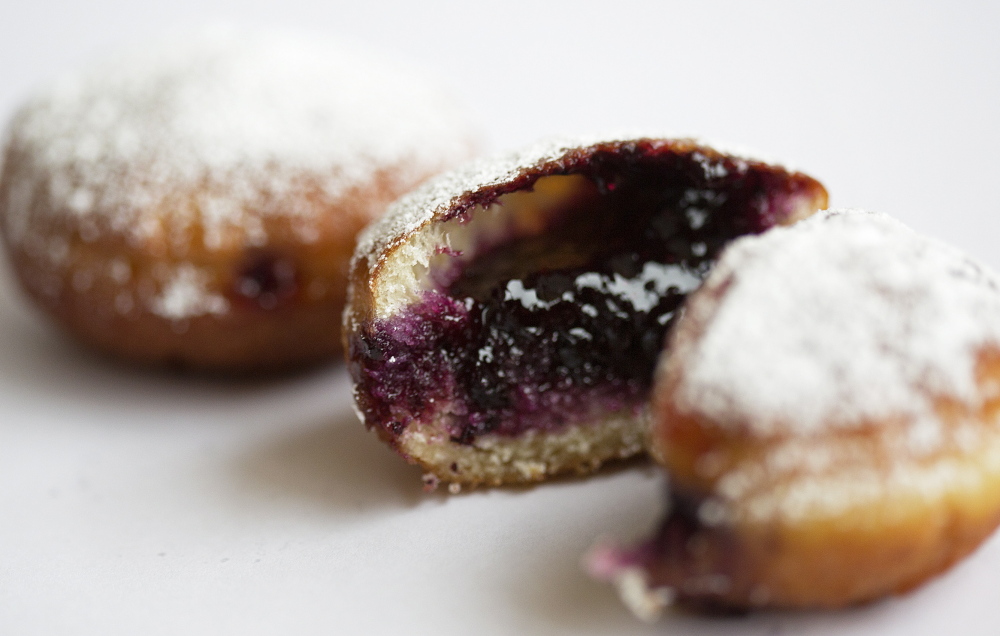It is customary to eat fried foods on Hanukkah because the holiday commemorates an oily miracle. After the Maccabean revolt in the second century BC, the Jews reclaimed their temple in Jerusalem. There was a shortage of oil needed to fuel the menorah that was supposed to burn in the temple throughout the night, every night. The oil in the jug that should have lasted only one night lasted eight.
Ashkenazi Jews traditionally make potato latkes, whereas Sephardic Jews eat “sufganiyot,” deep-fried doughnuts filled with jelly. In either recipe, cooking oil is key and once the food is eaten, the spent oil becomes a waste product. From a green standpoint, the “reduce, reuse, recycle” mantra applies.
Using too much oil to fry food is careless. Limit the amount of oil needed to fry anything by using a smaller pan. The swap cuts the number of latkes and sufganiyot you can cook simultaneously, but the products cook faster because the oil stays hotter. In the end, the net frying time may be roughly the same.
Cool the used oil completely, strain it of solids and store it in a sealed container in a cool, dark place. Fry oil can be reused multiple times before the smoke point, the temperature at which the oil itself starts to burn and chars your food before it’s fully cooked, is lowered to a point where the oil becomes useless for frying.
Label used oil containers to note what was fried in it to avoid flavor clashes (oil used to fry onion rings would make a doughnut taste like onions) or allergy complications (reusing fried shrimp oil could raise issues for french fry-eating guests who must avoid shellfish).
When the oil is finally spent (it will be more brown than golden), don’t pour it either down the drain or over the compost pile if you value either working pipes or quality organic matter.
Of the dozen municipal household waste disposal sites in Maine that I checked, most did not mention used cooking oil at all, and Brunswick’s specifically states it will not accept it.
“Most people just end up throwing it away,” said Janane Tripp of Garbage to Garden, a Portland-based composting service operating in a growing number of southern Maine communities. Users pay a monthly fee and receive a lidded bucket that they fill with food waste. Garbage to Garden picks up the full bucket weekly, replacing it with a clean one. Finished compost is free to any patron.
Tripp said Garbage to Garden will also take away containers of used oil. It gets converted into biodiesel fuel by Maine Standard Biofuels, which since 2006, has collected upwards of a million gallons of used fry oil from restaurants annually and converted it into fuel used by Oakhurst Dairy’s milk trucks, Downeast Duck Adventure’s amphibious vehicle and other customers.
Alex Pine, who is in charge of outreach at Maine Standard Biofuels, said his company welcomes home cooks dropping off used vegetable oil at the company’s location at 51 Ingersoll Drive in Portland. No donation is too small, but all oils should be vegetable (that makes the best fuel), ideally strained of cooked food and definitely sealed to avoid spillage.
Christine Burns Rudalevige is a food writer, recipe developer and tester, and cooking teacher in Brunswick. She writes about feeding her family Maine seafood at www.familyfish.net. Contact her at cburns1227@gmail.com.
HANUKKAH JELLY DOUGHNUTS (SUFGANIYOT)
This recipe is adapted from one published in “The Mile End Cookbook: Redefining Jewish Comfort Food from Hash to Hamantaschen” by Noah and Rae Bernamoff, owners of a Brooklyn, New York, deli from which the cookbook got its name. The main change is the infusion of Maine blueberry jelly into this very easy doughnut recipe, and I fried them in batches in a smaller pan to use the oil sparingly.
Makes 48 doughnuts
4 tablespoons instant yeast
1 cup lukewarm water
½ cup sugar
4 eggs, beaten
¼ cup (½ stick) unsalted butter, melted
1 teaspoon ground nutmeg
5 cups all-purpose flour
4 teaspoon kosher salt
Canola oil
2 cups Maine blueberry jelly
For finishing:
Powdered sugar
Add yeast, water, sugar, eggs, melted butter and nutmeg in a large bowl and stir to combine. Add flour and salt and stir, or mix with your hands, until the dough comes together. It will still be wet and sticky.
On a well-floured surface, knead and shape the dough into a thick disk; transfer it to a bowl that’s greased with oil.
Let dough rest in a warm, draft-free area for 1 hour.
Line a 10-by-15-inch baking sheet with parchment paper and coat the paper with oil. On a well-floured surface, flatten the dough and roll it out into a 1/4-inch-thick disk. Use a 2-inch round cookie cutter to cut out as many circles of dough as you can. Give the cutter a twist as you cut each doughnut, this helps to seal the edges and contain the doughnut. Transfer the circles to the prepared baking sheet.
Let the dough circles rest in a warm, draft-free area for a half-hour. Then heat about 2 inches of oil in a 4-quart saucepan, outfitted with a candy thermometer, over medium-high heat until very hot but not smoking (360 to 365 degrees F).
Working in batches, fry the doughnuts until they’re golden brown on one side, then flip them and finish frying, about 3 minutes total. Transfer the doughnuts to a paper towel to drain.
Place 1 cup of blueberry jelly into a pastry bag or a zip-close bag with a small hole cut from one corner.
When the doughnuts have cooled completely, use a small knife to gently burrow from the side of the doughnut into the center. Insert the tip of the bag into the opening and pipe in as much filling as possible. Repeat with the remaining doughnuts and filling.
Dust the doughnuts generously with powdered sugar. Serve immediately.
Send questions/comments to the editors.



Comments are no longer available on this story